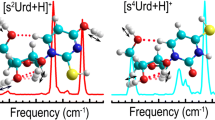Results from experimental designs intended for the creation of a laboratory model of a complex for optical spectroscopy of multiply charged thorium ions with a quadrupole Paul ion trap possessing a linear configuration for the development of a nuclear frequency standard are described. Preliminary experimental studies intended for the production of singly, doubly, and triply charged thorium ions from the solid-state compound thorium nitrate (IV) by the method of electron-beam evaporation are also presented. It is shown that, relative to singly charged ions, with the use of this method the fractions of triply and doubly charged thorium ions exceed the analogous values for the method of laser ablation used to produce these ions in laboratories in the United States and Germany. The method of electron-beam evaporation is made the basis of a newly developed complex for optical ultra-high resolution spectroscopy.




Similar content being viewed by others
References
W. D. Phillips, “Laser cooling and trapping of neutral atoms,” Rev. Mod. Phys., 70, No. 3, 721–741 (1998).
F. Riley, Frequency Standards. Principles and Applications [Russian translation], Fizmatgiz, Moscow (2009).
C. W. Chou et al., “Frequency comparison of two high-accuracy Al+ optical clocks,” Phys. Rev. Lett., 104, 070802 (2010).
B. J. Bloom et al., “An optical lattice clock with accuracy and stability at the 10–18 level,” Nature, 506, 71–75 (2014).
B. R. Beck et al., “Energy splitting of the ground-state doublet in the nucleus 229Th,” Phys. Rev. Lett., 98, 142501-1–142501-4 (2007).
C. J. Campbell et al., “Multiply charged thorium crystals for nuclear laser spectroscopy,” Phys. Rev. Lett., 102, 233004-1–233004-4 (2009).
E. Peik et al., “Prospects for a nuclear optical frequency standard based on Thorium-229,” http://arxiv.org/abs/0812.3548, accessed 06.06.2014.
C. J. Campbell et al., “A single-ion nuclear clock for metrology at the 19th decimal place,” http://arxiv.org/abs/110/2490, accessed 06.06.2014.
S. G. Porsev et al., “Excitation of the isomeric 229Th nuclear state via an electronic bridge process in 229 Th+,” Phys. Rev. Lett., 105, 182501-1–182501-4 (2010).
E. V. Tkalya and L. P. Yatsenko, “Creation of inverse population in the 229 Th ground-state doublet by means of a narrowband laser,” Laser Phys. Lett., 10, 105808-1–105808-6 (2013).
V. I. Troyan et al., “Generation of thorium ions by laser ablation and inductively coupled plasma techniques for optical nuclear spectroscopy,” Laser Phys. Lett., 10, 105301-1–105301-6 (2013).
A. V. Steele, “Barium ion cavity QED and triply ionized thorium ion trapping,” https://smartech.gatech.edu/bitstream/1853/26530/1/steele_adam_v_200812_phd.pdf, accessed 06.06.2014.
K. Zimmermann, “Experiments towards optical nuclear spectroscopy with Thorium-229,” https://www.ptb.de/cms/fileadmin/internet/fachabteilungen/abteilung_4/4.4_zeit_und_frequenz/pdf/2010_Zimmermann_Kai_Dissertation.pdf, accessed 06.06.2014.
The present study was carried out with the support of the Russian Foundation for Basic Research (Grant No. 14-08-00487).
Author information
Authors and Affiliations
Corresponding author
Additional information
Translated from Izmeritel’naya Tekhnika, No. 7, pp. 31–34, July, 2014.
Rights and permissions
About this article
Cite this article
Troyan, V.I., Borisyuk, P.V., Vasil’ev, O.S. et al. Quadrupole Paul Ion Trap in Complex for Optical Spectroscopy of Multiply Charged Thorium Ions for the Development of a Nuclear Frequency Standard. Meas Tech 57, 777–782 (2014). https://doi.org/10.1007/s11018-014-0535-8
Received:
Published:
Issue Date:
DOI: https://doi.org/10.1007/s11018-014-0535-8




